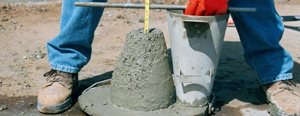Category
- Concrete Best Practices
All concrete has slump loss or it would never harden. In the normal slow congealing we call ‘setting’, the concrete first gradually loses all its slump and then proceeds to harden.
However…
What can be a cause for concern to the concrete user is an abnormally high rate of slump loss.
There are several causes of troublesome slump loss such as:

Time is commonly ignored when listing and discussing the causes of slump loss. Actually it is by far the most important of them all. Elapsed time, from mixing to placement, is always there and working every minute to reduce the slump.
Normal slump loss is merely a function of time.
Prevention
- Eliminate every possible delay
- Workable concrete must be established by trial and adjustment made as required under actual job condition
- One important adjustment that should be made after a suitable trial on the job, is enough extra slump in the concrete as mixed to offset normal slump loss and allow enough time for transportation and placing

The rate of slump loss is increased when concrete is mixed, handled or place of elevated temperature.
Whatever other causes of slump loss may be at work in a given situation, these seem to be quickly magnified at higher temperature.
Prevention

Concrete truck cooling with liquid nitrogen
- Cooling concrete materials such as aggregate and water ( ice, liquid nitrogen)
- Slow rate of setting time by retarder or supplementary cementing material
- Follow guidelines on Hot-Weather Concreting
3) AGGREGATE
Aggregates are often blamed for causing slump loss because they are dry or because they have latent absorption.
Prevention
- Sprinkled to make aggregate wet and pre-saturate so that they will not take water from concrete after mixing or during pumping
- Use shading for aggregate
- Highly absorption poor aggregate preferably should not be used




